Understanding the waves
Understanding the waves and the essential terminology
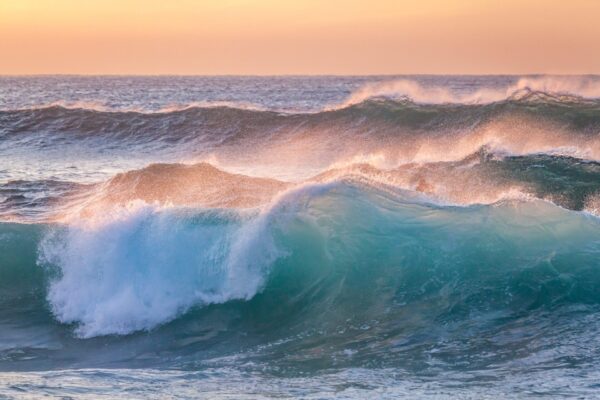
Understanding the waves
Understanding the waves and the essential terminology
Let’s talk about waves in a synthetic and simplified way, starting from their description, focusing on some characteristics of the wave motion of our seas. First we learn the essential terminology and what the descriptions in the bulletins or related to the weather models refer to.
The characteristics of the wave
H: height, vertical distance between the wave trough and the crest.
L: length between two crests.
T: period, time in seconds between the passage of two consecutive crests.
D: direction of origin of the waves.
R: slope, is the ratio between H and L.
V: speed of movement, space covered in a given unit of time.
Remember that since the waves are mainly generated by the wind:
- the careful observation of the wave motion can give valuable information on the wind that generated it;
- the wave motion can propagate faster and farther than the wind that generated it;
- if the long wave of a distant wind becomes shorter and higher, it is likely that that wind is strengthening or that the actual wind area is approaching.
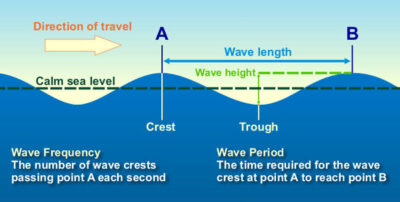
Credit: NOAA
Useful tips
- When the wind blows from the open sea towards the coast, the wave motion often generates choppy water and disturbances in the port. Moorings stretch and pull; the mooring lines must therefore be well adjusted and the boat kept further away from the dock.
- When choppy water disturbs mooring in the port, staying on board becomes problematic. Finding yourself in this situation in a marina, during the busiest season, really makes you long for the open sea or a good anchorage in a better sheltered bay.
- Consult the official Port Instructions carefully and check the characteristics of the seabed and the coast, with respect to the expected wave motion. This information can also help mariners to simplify the planning of port entry and exit.
- Unless it is a very well sheltered port, in the event of a deterioration in the state of the sea, expect to eventually be able to leave the berth if conditions become unsustainable.
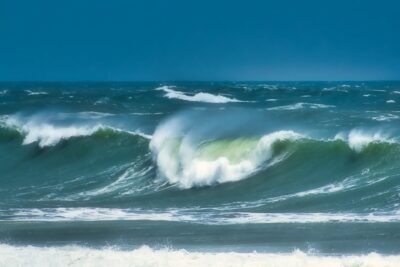
Credit: Craig Cameron
The characteristics of the wave motion
The main factors that determine wave motion:
- the strength, direction of the wind and the duration of its action on the sea;
- the fetch. This is the distance of open sea that a wave can travel without encountering obstacles;
- the current. If it is contrary to the direction of the waves generated by the wind, you get higher, steeper and shorter waves;
- the depth of the seabed. Waves break more easily near the coast. This is a decisive factor for safety when approaching a coast or when entering a harbour. This happens especially when the depth becomes less than half the wavelength.
Important!
It is clear that we must take into account the characteristics of the coastal seabed in relation to the state of the sea and the direction of the wave motion. The big and long swell offshore is generally not a problem for sailing but can become treacherous near a coast with shallow water or even near a steep coast where the reflected wave can cause a chaotic sea state. Therefore a good sailor, in determining the route, must always carefully consider the coastal navigation area and the characteristics of the entrance to the ports.
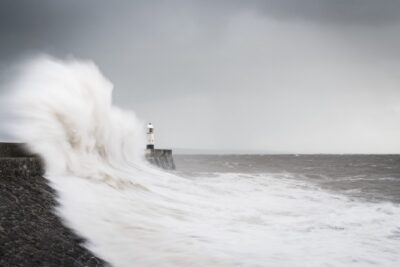
Credit: Marcus Woodbridge
Wave observation
The estimate of the height of the waves in navigation is often conditioned by a perspective error that makes them appear higher or lower than they actually are. In particular they appear higher in the phase of descent from a wave, when from the edge you can see the next wave coming towards you. So it happens to estimate waves of 3 meters when in reality these do not even reach two meters. In rough or very rough sea conditions, the waves do not have a regular cadence as higher waves alternate with a decidedly lower series of waves. In a sequence of waves the first wave is not the highest and most insidious.
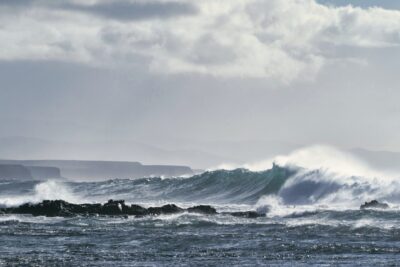
Credit: Axel Antas Bergkvist
Sea State – Douglas Scale
Below is the Douglas scale which describes the “significant wave height” in the area where the wind is blowing.
| Waves height in m. | MARE | MER | SEA | |
| 0 | 0 | Calmo | Calme (sans rides) | Calm (glassy) |
| 1 | 0 – 0,10 | Quasi calmo | Calme (ridée) | Calm (rippled) |
| 2 | 0,10 – 0,50 | Poco mosso | Belle (vaguellettes) | Smooth (wavelets) |
| 3 | 0,50 – 1,25 | Mosso | Peu agitée | Slight |
| 4 | 1,25 – 2,50 | Molto mosso | Agitée | Moderate |
| 5 | 2,50 – 4 | Agitato | Forte | Rough |
| 6 | 4 – 6 | Molto agitato | Très forte | Very rough |
| 7 | 6 – 9 | Grosso | Grosse | High |
| 8 | 9 -14 | Molto grosso | Très grosse | Very high |
| 9 | > 14 | Tempestoso | Enorme | Phenomenal |
Gianfranco Meggiorin



